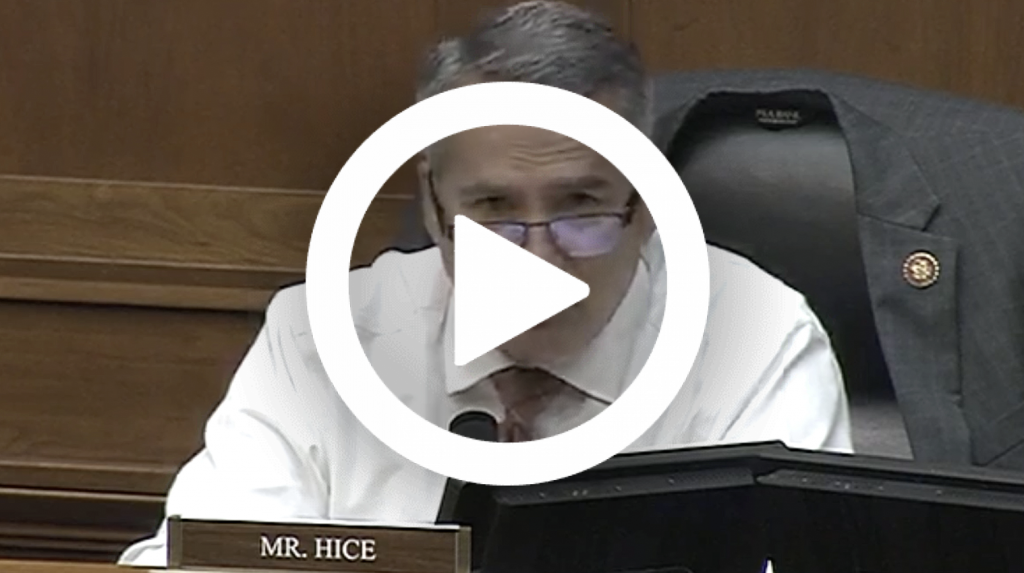Hice Opening Statement at Biannual FITARA Hearing
WASHINGTON—Today, the Subcommittee on Government Operations held its biannual hearing on the Federal Information Technology Acquisition Reform Act (FITARA). In his opening statement, Subcommittee Ranking Member Jody Hice (R-Ga.) emphasized the need to decipher whether the FITARA Scorecard and IT dashboard are effective tools in helping agency chief information officers and the Office of Management and Budget improve and oversee federal IT modernization. Hice also called for the subcommittee to focus on the status of IT modernization, whether our systems are as safe as possible, and how well the American people are being served. He concluded by emphasizing the need for federal employees to return to the workforce to better serve the American people.
The remarks as prepared for delivery are below.
Chairman Connolly, thank you for holding this hearing today.
I would first like to welcome Clare Martorana to the Committee for the first time in her role as Federal Chief Information Officer. We welcome you here today.
Given your experience as an agency CIO, I am interested to get your perspective of whether the FITARA scorecard – and the IT dashboard, for that matter—actually help agency CIOs manage their portfolios and help OMB with its own government-wide oversight efforts—or if these are just big reporting exercises. I look forward to hearing your perspective on that.
As the chairman said, this is the twelfth time we’ve had a FITARA scorecard.
And I know it has changed over time, but to me the overriding question is and always will be: Are we spending federal IT dollars well? At the end of the day, that is the issue.
Are projects coming in on time?
Are they on budget?
Do they do what they’re supposed to?
Why or why not?
These are just basic questions that we need to face and that we need answers for.
And that we need to keep a pulse on as we go through all of this.
These are important questions, and the answers to those questions shine the light on pretty much everything else – procurement, workforce, organizational structure and culture, and on and on.
So, the scorecard has evolved in the past – I think it is time to take a fresh look at the whole FITARA process through the lens I just described, with any reported metrics reflecting measurable legislative or executive branch policies. We must be objective and it must be quantifiable. It needs to be reported in a manner that is comparable agency-to-agency.
All of that is probably easier said than done.
I get that. Nothing around here is easy.
But I’d like to take a good hard look before we just move on to FITARA 13 and 14.
I also think the subcommittee needs to take a good look at a number of other issues:
What is the state of IT modernization generally speaking?
Yes, Congress passed the Modernizing Government Technology Act – the MGT Act – and now there’s billions of dollars in technology modernization funds to be spread around – but what’s it’s impact? What are we really getting in relation to modernization? Is it happening?
Is it having an impact that’s going to point towards the kind of modernization experiences that Ms. Martorana describes in her testimony?
Secondly, are our systems safe? This is an issue that’s come up time and again in hearings. As much as any system can be safe, are our systems safe?
In its testimony, GAO’s top concerns all revolve around cyber issues. It’s an issue we’ve got to deal with. I believe the scorecard needs to hone in on these types of questions.
Given the critical nature of this topic, is it enough to just have it be a subcomponent of the broader scorecard?
Or is it time to figure out a way to shine the spotlight on this area without tipping off the bad guys to our vulnerabilities?
I think we have got to address this.
Finally, how well are the American people being served?
I think the scorecard must reflect this.
At the end of the day, the federal government is here to serve the American people. We need to know how effective we are at doing that.
How easy is it to access government services and benefits through digital means?
In the private sector, you don’t survive for long if you don’t excel in this area. I believe we need to take a look at it on the federal perspective as well.
Ms. Martorana, as you have clearly stated in your written testimony, we share the view that “The federal government is fundamentally in the service business.” In fact, I couldn’t agree more.
All of the items I have mentioned here are important, but I would like to specifically ask Chairman Connolly if we could look at some of these issues going forward. I believe these are not only worthy of attention but of fine tuning the scorecard as a whole.
The last point I will make is this:
I have made clear the focus of the administration should be having federal employees return to their offices, but I am concerned that the emphasis instead appears to be on institutionalizing expanded telework.
I am glad that we are joined by the CIO of the Social Security Administration here today.
This is one of the agencies facing the greatest challenge in providing the American people with services they need.
If the Social Security Administration is not going to reopen more rapidly, I will be interested to learn how improved IT can help improve the citizen experience.
In closing, I want to thank the witnesses for being here.
I am eager to hear their insight and suggestions, and I look forward to engaging in conversation.
I yield back.
